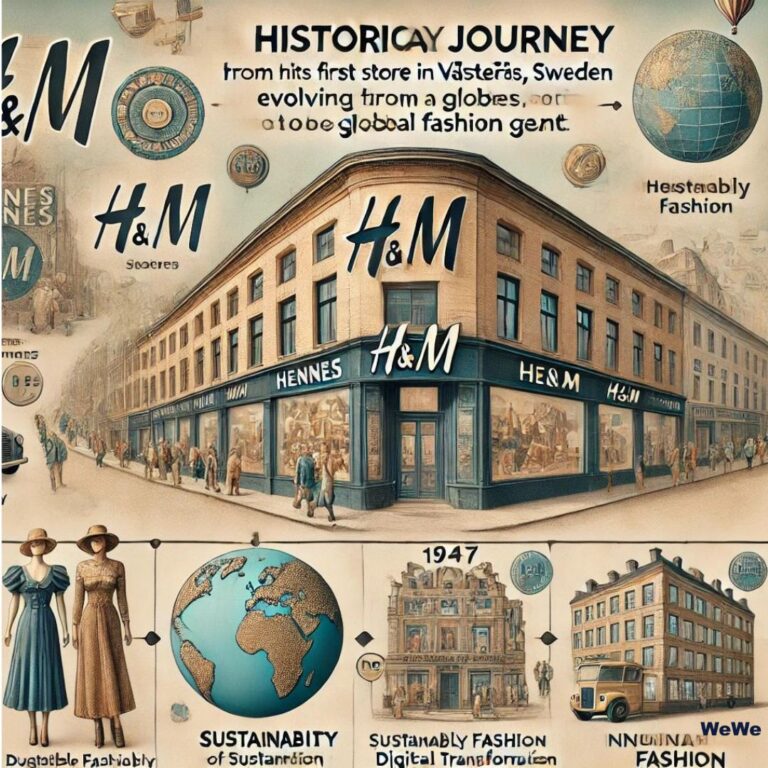Early Beginnings: 1947-1960s
The story of H&M, one of the world’s largest fashion retailers, begins in 1947 in Västerås, Sweden. Founded by Erling Persson, the company originally operated under the name Hennes, which is Swedish for “hers.” The store exclusively sold women’s clothing, positioning itself as a retailer offering fashionable yet affordable attire. Persson’s inspiration came from a trip to the United States, where he was impressed by the efficiency of high-volume retailing, particularly in women’s fashion.
Expansion and Rebranding: 1960s-1980s
In 1968, Hennes acquired the hunting and fishing equipment retailer Mauritz Widforss. This acquisition marked a pivotal shift in the company’s strategy, leading to the introduction of menswear into the product range. Consequently, the brand was rebranded as Hennes & Mauritz, which was later abbreviated to H&M. This period also saw the company expanding its footprint across Sweden.
The 1970s and 1980s were transformative years for H&M. The company began its international expansion, opening its first store outside Sweden in Norway in 1964. This move was followed by entries into Denmark and the United Kingdom. By the end of the 1980s, H&M had established a significant presence in several European countries.
Global Expansion and Diversification: 1990s-2000s
The 1990s and 2000s marked a period of rapid global expansion and diversification for H&M. The company made its entry into the U.S. market in 2000, setting up its first store in New York City. This move was a significant milestone, signaling H&M’s ambitions to become a global player in the fashion retail industry.
During this period, H&M also began to diversify its product offerings. The introduction of children’s clothing, accessories, and cosmetics helped broaden its appeal to a wider customer base. Furthermore, H&M started collaborating with high-end fashion designers, a strategy that brought high fashion to the masses at affordable prices. Collaborations with designers like Karl Lagerfeld, Stella McCartney, and Alexander Wang were met with immense enthusiasm and helped solidify H&M’s reputation as a trendsetter in the fashion industry.
Sustainability and Digital Transformation: 2010s-Present
As the fashion industry faced increasing scrutiny over its environmental impact, H&M began to focus on sustainability. In the early 2010s, the company launched its Conscious Collection, made from sustainable materials like organic cotton and recycled polyester. H&M also set ambitious goals to become climate positive and to use only sustainably sourced materials by 2030.
The rise of e-commerce posed both challenges and opportunities for H&M. The company invested heavily in its online platform, expanding its digital presence to over 50 markets worldwide. Innovations such as virtual fitting rooms and augmented reality shopping experiences were introduced to enhance the customer experience.
The Future of H&M
Looking ahead, H&M continues to evolve with the changing landscape of the fashion industry. The company is embracing technology to streamline operations and improve customer engagement. Initiatives like AI-driven inventory management and personalized marketing campaigns are examples of how H&M is leveraging technology to stay competitive.
H&M’s commitment to sustainability remains a core focus. The company is exploring new materials and technologies to reduce its environmental footprint. Innovations such as garment recycling programs and investments in sustainable textile startups underscore H&M’s dedication to creating a more sustainable fashion future.
From its humble beginnings in a small Swedish town to becoming a global fashion powerhouse, H&M’s journey is a testament to the vision and determination of its founder and the company’s ability to adapt to changing market dynamics. As H&M continues to innovate and lead in the fashion industry, its commitment to providing fashionable, affordable, and sustainable clothing remains at the heart of its brand philosophy.

